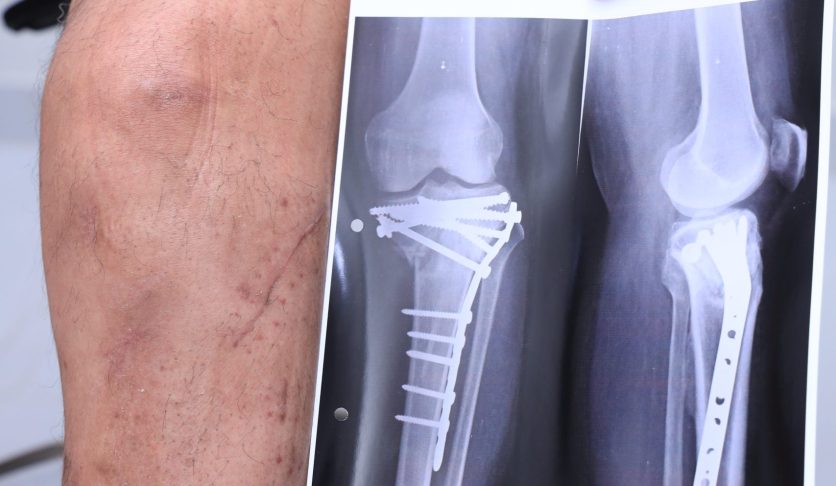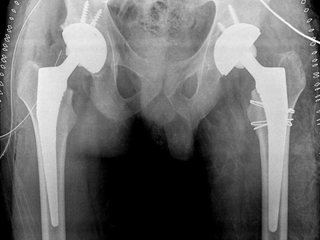Joint Replacement Surgery
- Home
- Joint Replacement Surgery

Joint Replacement
At Shreeji Orthopaedic and ENT hospital, Ahmedabad, Gujarat, India all joint replacement surgery is available. Mainly knee replacement ( T.K.R. ), hip joint Replacement ( T.H.R. ), shoulder and elbow joint replacement surgery. Sometimes the best way to relieve pain and restore function to a joint is to replace all or part of it with a mechanical prosthesis. Prostheses are intended to relieve pain associated with arthritis, other chronic conditions, or traumatic injury. The most commonly replaced joints are the hip, knee, shoulder and wrist.
What is Joint Replacement?
Joints are formed by the ends of two or more bones connected by tissue called cartilage. Healthy cartilage serves as a protective cushion, allowing smooth, low-friction movement of the joint. If the cartilage becomes damaged by disease or injury, the tissues around the joint become inflamed, causing pain. With time, the cartilage wears away, allowing the rough edges of bone to rub against each other, causing more pain.
When only some of the joint is damaged, a surgeon may be able to repair or replace just the damaged parts. When the entire joint is damaged, a total joint replacement is done. To replace a total hip or knee joint, a surgeon removes the diseased or damaged parts and inserts artificial parts, called prostheses or implants.
Why Joint Replacement?
The most common reason for having a hip or knee replaced is osteoarthritis, according to the National Institute of Arthritis and Musculoskeletal and Skin Diseases (NIAMS). This degenerative joint disease, marked by the breakdown of the joint’s cartilage, is not limited to older people. Although it most commonly affects people over age 45, younger men and women also can get this disease.
Some people are born with a deformed joint or defective cartilage, which leads to osteoarthritis. Excess weight, joint fracture, ligament tears, or other injury can damage cartilage and cause osteoarthritis.
Rheumatoid arthritis is another condition that may be alleviated by hip or knee joint replacement. This chronic inflammation of the joint lining causes pain, stiffness, and swelling. The inflamed lining can invade and damage bone and cartilage. Rheumatoid arthritis generally starts in middle age, but can also affect children and young adults.
Loss of bone caused by poor blood supply (avascular necrosis), which led to Van Halen’s hip replacement, and bone tumors may be other reasons for joint replacement.
Hip Replacement Surgery

The hip joint is a ball and socket, allowing a wide range of motion. The ball of the joint, the top of the thighbone (femoral head), moves within the hollow socket (acetabulum) of the pelvis. A layer of cartilage allows the ball to glide smoothly inside the socket.
In total hip replacement, the surgeon cuts away the ball part of the joint, replacing it with a ball attached to a stem that is wedged into a hollowed-out space in the thighbone. Damaged cartilage and bone are removed from the socket and a cup-like component is inserted into the socket.
Hip replacements may be cemented or uncemented. If cemented, the hip parts are held in place with a fast-curing “bone cement” made from a type of polymer. If uncemented, the joint components are specially made to either press into the bone for a tight fit (press-fit) or to allow new bone to grow into the porous surface of the implant, holding it in place (biological fixation).
Hip Resurfacing Our Values
An alternative to total hip replacement is an operation called hip resurfacing. Unlike the prostheses used in total hip replacement, which are made to replace the femoral head, resurfacing prosthesis designs allow the head to be preserved and reshaped. The resurfaced bone is then capped with a metal prosthesis. Like total hip replacement, the socket is fitted with a prosthesis.
Knee Replacement Surgery

The largest joint in the body, the knee joint is formed where the lower part of the thighbone (femur) joins the upper part of the shinbone (tibia) and the kneecap (patella). Shock-absorbing cartilage covers the surfaces where these three bones touch.
In a standard total knee replacement, the damaged areas of the thighbone, shinbone and kneecap are removed and replaced with prostheses. The ends of the remaining bones are smoothed and reshaped to accommodate the prostheses. Pieces of the artificial knee are typically held in place with bone cement.
Most who opt for knee joint replacement are generally happy with the results. Ninety percent of those who have total knee replacement report fast pain relief, improved mobility, and better quality of life, according to a panel of independent experts.
The Risks of Replacement
Like any surgery, hip and knee joint replacement carries certain life-threatening risks, such as infection, blood clots and complications from anesthesia. Other complications include nerve damage, dislocation or breakage after surgery, and wearing out or loosening of the joint over time. After hip replacement surgery, one leg may be shorter than the other.
Infection is an ongoing risk for people with joint replacements. Not only can it occur in the hospital, but it can happen years later if bacteria travel through the bloodstream to the replacement area.
In the rare case that an infection spreads to the new joint and does not clear up with antibiotic treatment, the joint must be replaced. This usually requires two surgeries–one to remove the infected joint and another surgery later to insert the new joint. Between surgeries, the infection is treated with antibiotics.
The Wear Problem
The most commonly used FDA-approved joint prostheses for knees and hips are made of metal and plastic. The metal is usually titanium or a mixture of cobalt and chromium. The plastic is a high-density polyethylene.
Although the metal in a prosthesis is highly polished and the polyethylene is intended to be wear-resistant, the daily rubbing of these surfaces against each other during normal movements creates tiny particles of debris. After many years, these wear particles may damage the surrounding bone, loosen the prosthesis, and require another knee or hip joint replacement.
“The ‘Achilles tendon’ of any artificial joint over the long term is wear,” says Dr. Hardik Shah. Simple logic is – “Any time you have parts moving against each other, there has to be wear.”
In an effort to solve the wear problem of metal-on-polyethylene in the hip joint, manufacturers have produced hip prostheses with three other kinds of surfaces: metal-on-metal, ceramic-on-polyethylene, and ceramic-on-ceramic. Unlike the clay ceramic used in pottery, the ceramic used in hip joint replacements is made from aluminum or zirconium chemically combined with oxygen for strength and durability.
How Do You Know It's Time for Surgery?
- you are unable to sleep at night because of the pain
- you feel that the pain from your arthritis is keeping you from regular outings, such as visiting friends, going shopping or taking a vacation
- your activity is restricted to the point where you have trouble getting out of a chair, going up stairs, getting off the toilet, or getting up from the floor.
